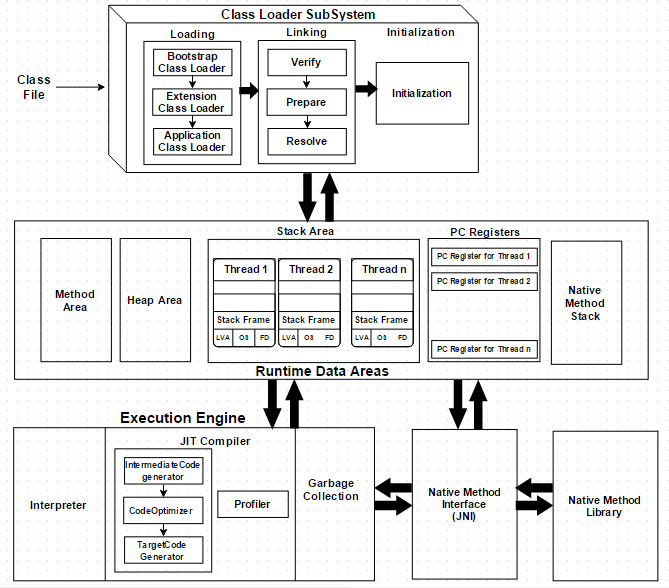In the world of software development, technology doesn’t exist in a vacuum. It’s surrounded by narratives, marketing, community dogma, and strategic messaging designed to influence our choices as developers. This is the realm of the “Java psyop”—a metaphorical term for the subtle and overt psychological operations that shape the Java ecosystem news. From corporate-backed initiatives to grassroots community trends, these forces guide which frameworks we adopt, which architectural patterns we praise, and how we perceive the future of the platform. This isn’t about conspiracy; it’s about understanding the powerful currents of influence in a mature, competitive, and constantly evolving technological landscape.
The goal of this article is to equip you with a framework for critical thinking. We will deconstruct some of the most significant narratives in the modern Java world, from the performance renaissance driven by Project Loom to the architectural debates surrounding reactive programming and AI integration. By analyzing the “why” behind the Java news, we can move beyond the hype, make more informed technical decisions, and become more effective engineers. We’ll explore practical code examples, discuss best practices for navigating these influences, and build our own “counter-intelligence” to separate genuine innovation from persuasive marketing.
The Core Narrative: Reclaiming Performance and Modernity
For years, a persistent narrative dogged the Java ecosystem: that it was slow, bloated, and ill-suited for the demands of modern, highly concurrent applications. Competitors like Go and Node.js built their entire identity around lightweight concurrency models, making Java’s traditional thread-per-request model seem archaic. The most significant “psyop” from the Java camp in recent years has been a direct and powerful counter-offensive to this narrative, spearheaded by Project Loom and its introduction of virtual threads in Java 21.
Project Loom: The Concurrency Counter-Offensive
The messaging around Project Loom news has been a masterclass in strategic communication. It wasn’t just about introducing a new feature; it was about reframing Java’s identity. The key message: you can have massive scalability and high throughput without abandoning the simple, familiar, synchronous-style code you’ve been writing for years. This directly targets the primary pain point of reactive programming’s complexity, which was the previous answer to the C10K problem. Virtual threads are presented as the “easy button” for concurrency, a narrative designed to win back the hearts and minds of developers who felt left behind or were considering other platforms.
This initiative, now a cornerstone of Java 21 news, is a core part of the broader OpenJDK news cycle, demonstrating a commitment to evolving Java SE for the cloud-native era. Let’s see how this narrative translates to code. Consider a simple web server task that involves a blocking I/O call, like fetching data from a remote service.
import java.util.concurrent.ExecutorService;
import java.util.concurrent.Executors;
import java.util.stream.IntStream;
public class ConcurrencyDemonstration {
// A simulated network call that blocks the thread
public static void performBlockingTask(int taskNumber) {
System.out.println("Executing task " + taskNumber + " on thread: " + Thread.currentThread());
try {
// Simulate a 1-second blocking I/O operation (e.g., API call, DB query)
Thread.sleep(1000);
} catch (InterruptedException e) {
Thread.currentThread().interrupt();
}
}
public static void main(String[] args) {
System.out.println("--- Using Platform Threads ---");
// Using a fixed pool of OS-level platform threads
try (ExecutorService executor = Executors.newFixedThreadPool(200)) {
IntStream.range(0, 1000).forEach(i -> {
executor.submit(() -> performBlockingTask(i));
});
}
// The above would struggle and consume significant system resources.
System.out.println("\n--- Using Virtual Threads (Java 21+) ---");
// The "new" narrative: simple code, massive scale
try (ExecutorService executor = Executors.newVirtualThreadPerTaskExecutor()) {
IntStream.range(0, 1000).forEach(i -> {
executor.submit(() -> performBlockingTask(i));
});
}
// This handles 1000 concurrent blocking tasks with ease, using few OS threads.
System.out.println("All virtual thread tasks submitted.");
}
}
The code demonstrates the power of the narrative. The logic for the task is identical. The only change is the `ExecutorService` implementation. The Java virtual threads news promotes this as a revolutionary simplification, a way to achieve concurrency without the mental overhead of callbacks or complex reactive chains. This is a powerful “psyop” aimed squarely at improving developer productivity and keeping Java competitive.
The Battle for the Developer Mind: Frameworks and Architectural Dogma
Frameworks are one of the most potent vectors for ideological influence in software. They don’t just provide libraries; they promote a specific way of thinking about and solving problems. The Spring news cycle, in particular, showcases how a dominant framework can shape the architectural choices of millions of developers. From dependency injection to AOP, and now to reactive programming and AI, Spring Boot often defines what it means to build a “modern” Java application.
The Reactive “Psyop” and the AI Gold Rush

For a time, the Reactive Java news dominated the discourse. The narrative was that to build resilient, scalable systems, you *must* adopt a fully non-blocking, reactive stack. Frameworks like Spring WebFlux were presented as the future, and developers using traditional blocking servlets were made to feel they were behind the curve. While reactive programming is a powerful tool for certain use cases (like high-frequency streaming), the “psyop” was convincing developers it was the *only* solution for all high-performance needs. The arrival of virtual threads has now created a fascinating counter-narrative, giving developers a valid, often simpler alternative.
More recently, a new gold rush has begun: AI. The rise of Spring AI news and community projects like LangChain4j news represents a push to make Java a first-class citizen in the world of Large Language Models (LLMs). The underlying message is clear: you don’t need to switch to Python to build sophisticated AI-powered applications. This is a strategic move to keep developers within the Java ecosystem by providing familiar, Spring-integrated tools for a new, high-demand domain.
Let’s model this with an interface for an AI service, which could be implemented by Spring AI or another library, and see how it might be used in a reactive Spring Boot controller.
import org.springframework.web.bind.annotation.GetMapping;
import org.springframework.web.bind.annotation.RequestParam;
import org.springframework.web.bind.annotation.RestController;
import reactor.core.publisher.Mono;
// 1. Define a clear interface for the AI service.
// This decouples the controller from the specific implementation (Spring AI, LangChain4j, etc.)
interface AiContentService {
Mono<String> generateContent(String topic);
}
// 2. A concrete implementation (could be backed by a real AI model)
// This class would contain the complex logic for calling an LLM.
class OpenAiContentService implements AiContentService {
@Override
public Mono<String> generateContent(String topic) {
// In a real app, this would make an async HTTP call to an AI provider.
// We simulate a network delay and return a Mono.
System.out.println("Generating content for: " + topic);
return Mono.just("Here is some AI-generated content about '" + topic + "'.");
}
}
// 3. The Spring Boot Reactive Controller
@RestController
public class AiArticleController {
private final AiContentService aiService;
// Use constructor injection - a core Spring best practice.
public AiArticleController() {
// In a real Spring app, this would be injected via @Autowired
this.aiService = new OpenAiContentService();
}
@GetMapping("/generate-article")
public Mono<String> getAiGeneratedArticle(@RequestParam String topic) {
// The controller uses the reactive stream (Mono) returned by the service.
// This demonstrates the "reactive way" of handling requests.
return aiService.generateContent(topic);
}
}
This example showcases the reactive paradigm with `Mono`, a stream that emits 0 or 1 item. The `AiContentService` interface is crucial; it represents an abstraction over a complex domain, allowing the underlying implementation to change without affecting the controller. This is the kind of clean, decoupled design that frameworks encourage, subtly guiding our architectural decisions.
Advanced Maneuvers: Deconstructing Common “Wisdom”
Beyond major features and frameworks, the Java ecosystem is filled with ingrained “wisdom”—patterns and beliefs that are often repeated without critical examination. These can be considered micro-psyops, shaping our daily coding habits. Understanding their origins and trade-offs is key to becoming a more discerning developer.
The Null Object Pattern vs. The “Optional” Dogma
Tony Hoare’s “billion-dollar mistake” quote regarding null references created a powerful narrative against `null`. This led to the rise of solutions, with `java.util.Optional` in Java 8 being the most prominent. The dogma around `Optional` is strong: “always use `Optional` for return types that might be empty.” While often good advice, it’s not a silver bullet and can lead to verbose code if overused. An older, but still highly relevant, pattern is the Null Object pattern. This is a behavioral design pattern where a null object replaces a `null` reference, providing default, do-nothing behavior.
The latest Null Object pattern news is that it remains a fantastic tool for simplifying code and avoiding conditional checks, especially in strategies or chains of responsibility. Let’s model a logging system where a “null” logger is preferable to a `null` check.
// 1. The Interface defines the contract
interface MessageLogger {
void log(String message);
}
// 2. A real implementation that does work
class ConsoleMessageLogger implements MessageLogger {
@Override
public void log(String message) {
System.out.println("LOG: " + message);
}
}
// 3. The Null Object implementation
// It adheres to the same interface but does nothing.
class NullMessageLogger implements MessageLogger {
@Override
public void log(String message) {
// Intentionally empty. No operation.
}
}
// 4. The Client code, which is now simplified
class ApplicationService {
private final MessageLogger logger;
// The logger is never null, so no checks are needed.
public ApplicationService(MessageLogger logger) {
// We could use Objects.requireNonNull(logger), but the factory below prevents null.
this.logger = logger;
}
public void performAction() {
// No "if (logger != null)" check is required!
logger.log("Starting action...");
// ... business logic ...
logger.log("Action finished.");
}
}
// 5. A Factory to provide the correct logger
class LoggerFactory {
public static MessageLogger getLogger(boolean loggingEnabled) {
if (loggingEnabled) {
return new ConsoleMessageLogger();
} else {
return new NullMessageLogger();
}
}
}
public class NullObjectDemo {
public static void main(String[] args) {
System.out.println("--- Logging Enabled ---");
MessageLogger enabledLogger = LoggerFactory.getLogger(true);
ApplicationService service1 = new ApplicationService(enabledLogger);
service1.performAction();
System.out.println("\n--- Logging Disabled ---");
MessageLogger disabledLogger = LoggerFactory.getLogger(false);
ApplicationService service2 = new ApplicationService(disabledLogger);
service2.performAction(); // Executes safely with no output and no null pointer exceptions.
}
}
This pattern is a piece of classic Java wisdom tips news that provides a clean alternative to `Optional` in certain scenarios, especially when dealing with dependency injection. The “psyop” here is the subtle pressure to believe one solution (`Optional`) is always superior to others.
The Licensing FUD and the OpenJDK Renaissance
Finally, no discussion of Java influence is complete without mentioning the FUD (Fear, Uncertainty, and Doubt) surrounding Oracle Java news and licensing. For years, competing ecosystems used this as a weapon, creating a narrative that “Java is no longer free.” This “psyop” was highly effective, causing significant confusion. The Java community’s response was a powerful counter-narrative: the rise and promotion of the OpenJDK ecosystem. Organizations like Eclipse Adoptium, and vendors like Azul Zulu, Amazon Corretto, and BellSoft Liberica, rallied around OpenJDK as the true, free, community-driven heart of Java. This successfully shifted the conversation from Oracle’s commercial JDK to the vibrant, multi-vendor open-source ecosystem we have today.

Best Practices: Building Your Counter-Intelligence
To effectively navigate the Java psyop, you must cultivate a healthy skepticism and a commitment to fundamentals. Here are some actionable best practices to build your “counter-intelligence” and make sound technical judgments.
1. Question the Narrative
When you see a new trend, framework, or feature gaining traction, ask critical questions. Who is promoting it and why? What problem does it *really* solve? Is it a genuine 10x improvement, or an incremental one with significant adoption costs? For example, before rewriting a service to be fully reactive, use profiling tools to determine if I/O is truly your bottleneck. The latest Java performance news isn’t just about new features, but also about better observability tools to make these decisions.
2. Master the Fundamentals
The strongest defense against hype is a deep understanding of core Java SE. Whether it’s Java 8 news about Streams or Java 17 news about records and sealed classes, mastering the language itself gives you the foundation to evaluate any framework or library. A developer with strong Java concurrency news knowledge can better assess the trade-offs between virtual threads, reactive streams, and traditional thread pools. This is especially true for those on a Java self-taught news journey, where focusing on the core platform is paramount.

3. Trust, but Verify with Tooling
Don’t take performance claims or architectural benefits at face value. Verify them in the context of your own application.
- Build Tools: Master your build tools like Maven news and Gradle news. Understand your dependency tree and be deliberate about what you include.
- Testing Frameworks: Use JUnit news and Mockito news to write robust tests that validate behavior. Write benchmarks using tools like JMH (Java Microbenchmark Harness) to test performance claims.
- JVM Knowledge: Keep up with JVM news. Understanding how things like JIT compilation, garbage collection, and now virtual threads work under the hood is the ultimate tool for cutting through marketing fluff. This also includes understanding other JVM languages and their own ecosystems.
4. Diversify Your Information Sources
Don’t get your Java news from a single source. Follow the official OpenJDK mailing lists, read blogs from different vendors (Oracle, Azul, Red Hat), engage with community leaders on social media, and read experience reports from companies that have adopted—or rejected—a new technology. A balanced information diet is the best antidote to a successful “psyop.”
Conclusion
The “Java psyop” is not a conspiracy but the natural state of a healthy, dynamic, and commercially significant technology ecosystem. It is the sum of all the stories we are told—by vendors, by framework authors, by community leaders, and by ourselves—about the best way to build software. From the grand, strategic narratives like Project Loom’s revitalization of Java’s concurrency model to the subtler influences of architectural dogma, these forces are constantly at play.
Your role as a modern Java developer is not to resist these forces, but to understand them. By cultivating a critical mindset, mastering fundamental principles, and verifying claims with empirical data, you can navigate the hype. You can distinguish genuine, game-changing innovations from clever marketing and make choices that are right for your projects, your teams, and your career. The ultimate goal is to be an active, informed participant in the evolution of the Java ecosystem, not a passive recipient of its narratives.

